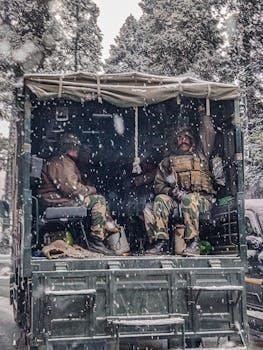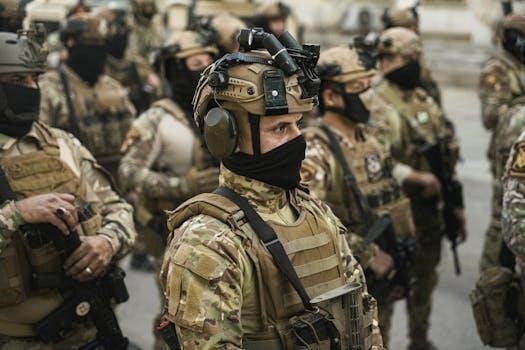Overview of Army Regulation 190-11
Army Regulation 190-11 outlines the policies and procedures for the physical security of arms, ammunition, and explosives (AA&E). It’s designed to protect these items across the Army, including active duty, reserve, and ROTC units.
Purpose of AR 190-11
The primary purpose of AR 190-11 is to establish comprehensive standards for the physical security of arms, ammunition, and explosives (AA&E) within the Department of the Army. This regulation aims to prevent theft, loss, misuse, and compromise of AA&E, ensuring the safety and security of personnel and resources. It provides detailed guidelines for storage, transportation, and handling of AA&E, covering various aspects such as facility security, access control, and inventory management. Furthermore, AR 190-11 aims to standardize security practices across all Army installations and units, promoting consistency and accountability. By adhering to this regulation, the Army seeks to maintain the integrity and readiness of its AA&E, safeguarding national security interests and minimizing potential risks associated with these sensitive items.
Scope of AR 190-11 Application
AR 190-11 applies to all active Army, Army Reserve, and Army National Guard units, installations, and activities worldwide. It encompasses all personnel, both military and civilian, who are responsible for the physical security of arms, ammunition, and explosives (AA&E). This regulation also extends to Reserve Officer Training Corps (ROTC) units, except where specifically exempted. The scope includes all aspects of AA&E management, from initial receipt and storage to transportation, issue, and disposal. It covers various types of facilities, including armories, magazines, and storage areas. Additionally, AR 190-11 addresses security requirements for AA&E during field training exercises and other operational activities. The regulation ensures comprehensive coverage of AA&E security across the entire Army enterprise, promoting a standardized approach to safeguarding these critical assets and maintaining operational readiness. It is designed to enhance the protection measures for arms, ammunition, and explosives.

Key Changes and Updates to AR 190-11
Recent updates to AR 190-11 involve enhanced monitoring during field training, restrictions on ROTC/JROTC storage, and new screening forms for transporting sensitive materials. These changes aim to improve security.
Ammunition and Explosives Monitoring During Field Training
AR 190-11 emphasizes closer monitoring of ammunition and explosives during all field training exercises. This increased oversight aims to prevent loss, theft, or misuse of these sensitive items. Commanders are responsible for implementing stringent accountability procedures throughout the training lifecycle, from initial issue to final turn-in. Detailed records must be maintained, documenting quantities, locations, and personnel responsible for the AA&E. Regular inventories and inspections are crucial to ensure compliance. Any discrepancies must be immediately reported and investigated. The regulation seeks to minimize risks associated with AA&E during realistic training scenarios, enhancing overall security.
Restrictions on ROTC/JROTC Units
AR 190-11 places specific restrictions on ROTC and JROTC units regarding the storage of certain categories of arms and ammunition. These units are generally prohibited from storing live ammunition or certain types of weapons, due to security concerns and limited resources for maintaining stringent security protocols. Any exceptions to this policy require a waiver from higher headquarters, based on a thorough risk assessment and demonstration of adequate security measures. This restriction aims to protect cadets and prevent unauthorized access to dangerous items. The regulation prioritizes safety and accountability within these educational programs, aligning with broader Army security standards.
New Screening and Evaluation Forms
AR 190-11 introduces updated screening and evaluation forms for personnel involved in transporting sensitive materials, including arms, ammunition, and explosives. These forms enhance the vetting process, ensuring that individuals handling such items are properly screened and deemed trustworthy. The evaluations assess an individual’s background, security awareness, and potential risk factors. The use of these standardized forms promotes consistency and thoroughness in personnel screening across different Army installations. The goal is to mitigate the risk of theft, misuse, or compromise of sensitive materials by personnel who may pose a security threat. These measures contribute to overall safety and compliance.
Physical Security Requirements
AR 190-11 details physical security requirements for arms, ammunition, and explosives storage. This includes guidelines for locking mechanisms, storage area construction, and access control to prevent unauthorized entry and theft.
Locking Mechanisms and Standards
AR 190-11 emphasizes the importance of robust locking mechanisms to secure arms, ammunition, and explosives. Specified locks must meet stringent standards to prevent unauthorized access and potential theft. The regulation mandates specific lock types based on the sensitivity and risk associated with the stored items. For highly sensitive items, locks designed to prevent key duplication are often required, enhancing overall security; Combination locks are permissible under certain conditions, but AR 190-11 dictates strict procedures for managing and changing combinations regularly. This ensures that compromised combinations do not lead to security breaches. Regular inspections and maintenance of locking systems are also essential to maintain their effectiveness. The goal is to create a multi-layered security approach.
Storage Area Security
AR 190-11 provides detailed guidance on maintaining secure storage areas for arms, ammunition, and explosives. These standards aim to prevent unauthorized access, theft, and misuse. Physical barriers, such as reinforced doors, walls, and windows, are crucial components of storage area security. Access control measures, including authorized personnel lists and entry procedures, must be strictly enforced. Regular inspections of storage areas are required to identify vulnerabilities and ensure compliance with regulations. Proper lighting, alarm systems, and surveillance technologies further enhance security. Environmental controls are also essential to prevent damage to stored items. Inventory management and accountability procedures are critical for tracking the location and status of arms, ammunition, and explosives. Effective key control systems are necessary to prevent unauthorized duplication and access. These comprehensive measures ensure a high level of security.

Compliance and Enforcement
Compliance with AR 190-11 is mandatory for all Army personnel and units. Enforcement involves regular inspections, audits, and accountability measures. Failure to comply can result in disciplinary actions and security breaches.
Fort Lewis Specific Guidelines
Fort Lewis, now Joint Base Lewis-McChord (JBLM), has specific guidelines supplementing AR 190-11 to enhance security for arms, ammunition, and explosives. These guidelines address local conditions and potential threats specific to the base’s operational environment. They are to be used in conjunction with AR 190-11 and its supplements, like Forces Command and Training Command Supplement 1.
JBLM emphasizes stringent protective measures, including key control systems, master files, and detailed security procedures. Locks used must meet specific requirements to prevent unauthorized key duplication. These measures aim to ensure compliance with safety protocols and enhance the overall security posture for military operations at JBLM, reflecting a commitment to safeguarding sensitive items and maintaining operational readiness.
Fort Sill Regulation 190-11
Fort Sill Regulation 190-11 is an installation-specific document that supplements AR 190-11, providing detailed guidance on the physical security of arms, ammunition, and explosives (AA&E) at Fort Sill. Effective as of October 20, 2022, this regulation tailors the broader Army policies to the unique circumstances and requirements of the Fort Sill military installation.
It outlines enhanced protective measures and security protocols to safeguard AA&E against theft, misuse, or accidental incidents. The regulation emphasizes compliance with safety standards and operational readiness, ensuring that all personnel understand and adhere to the specific security procedures in place at Fort Sill. Fort Sill Regulation 190-11 helps maintain a secure environment for military operations.

Related Regulations and Documents
AR 190-11 works in conjunction with other regulations and documents. These include FORSCOM and TRADOC supplements, which provide additional guidance. These related materials ensure comprehensive security protocols across different Army commands.
AR 190-11 Forces Command and Training Command Supplement 1
The AR 190-11 Forces Command (FORSCOM) and Training and Doctrine Command (TRADOC) Supplement 1 provides additional, specific guidance tailored to the unique needs of these commands. This supplement enhances the baseline requirements outlined in AR 190-11 to ensure effective physical security of arms, ammunition, and explosives (AA&E) within FORSCOM and TRADOC units.
The supplement addresses aspects such as storage procedures, access control, and monitoring protocols. It ensures that units under FORSCOM and TRADOC adhere to stringent security standards. It adapts the general guidelines of AR 190-11 to the specific operational environments and training requirements of these commands, promoting a layered and robust security posture for AA&E.
Relationship to Other Army Regulations
AR 190-11, while comprehensive, does not operate in isolation. It is intrinsically linked to other Army regulations that govern various aspects of military operations and security. For instance, it complements regulations concerning personnel security, risk management, and inventory control.
Specifically, it aligns with regulations addressing the possession and registration of privately owned weapons on military installations, ensuring a cohesive approach to firearms management. Furthermore, AR 190-11 supports overall safety protocols. This ensures compliance with broader Army directives on security and readiness. By working in conjunction with other regulations, AR 190-11 contributes to a comprehensive framework for maintaining security and operational effectiveness.

Accessing AR 190-11 PDF and Resources
The official AR 190-11 PDF can typically be found on the Army Publishing Directorate website. The National Archives and Records Administration (NARA) also maintains government and historical records.
Official Army Website
The primary source for accessing the official AR 190-11 PDF is the Army Publishing Directorate website, often found under the publications section of the U.S. Army’s main website. This site serves as the central repository for all official Army regulations and documents, ensuring users have access to the most current and authoritative versions. Navigating the Army’s website to locate the specific regulation may require utilizing the search function, inputting “AR 190-11” to filter results. Users should verify the publication date to ensure they are referencing the latest edition, as regulations are periodically updated. The site may also offer related resources.
National Archives and Records Administration (NARA)
The National Archives and Records Administration (NARA) serves as a repository for government and historical records, including potentially archived versions of Army Regulations. While the official, current version of AR 190-11 is best accessed through the Army Publishing Directorate, NARA might hold historical versions or related documents. NARA’s website provides search tools to explore their holdings, though finding specific Army Regulations may require detailed search terms and an understanding of record management practices. Accessing documents from NARA might involve digital downloads or physical visits to their facilities. NARA preserves important government records, ensuring public access to historical information. For the most up-to-date regulation, consult the official Army website first.
